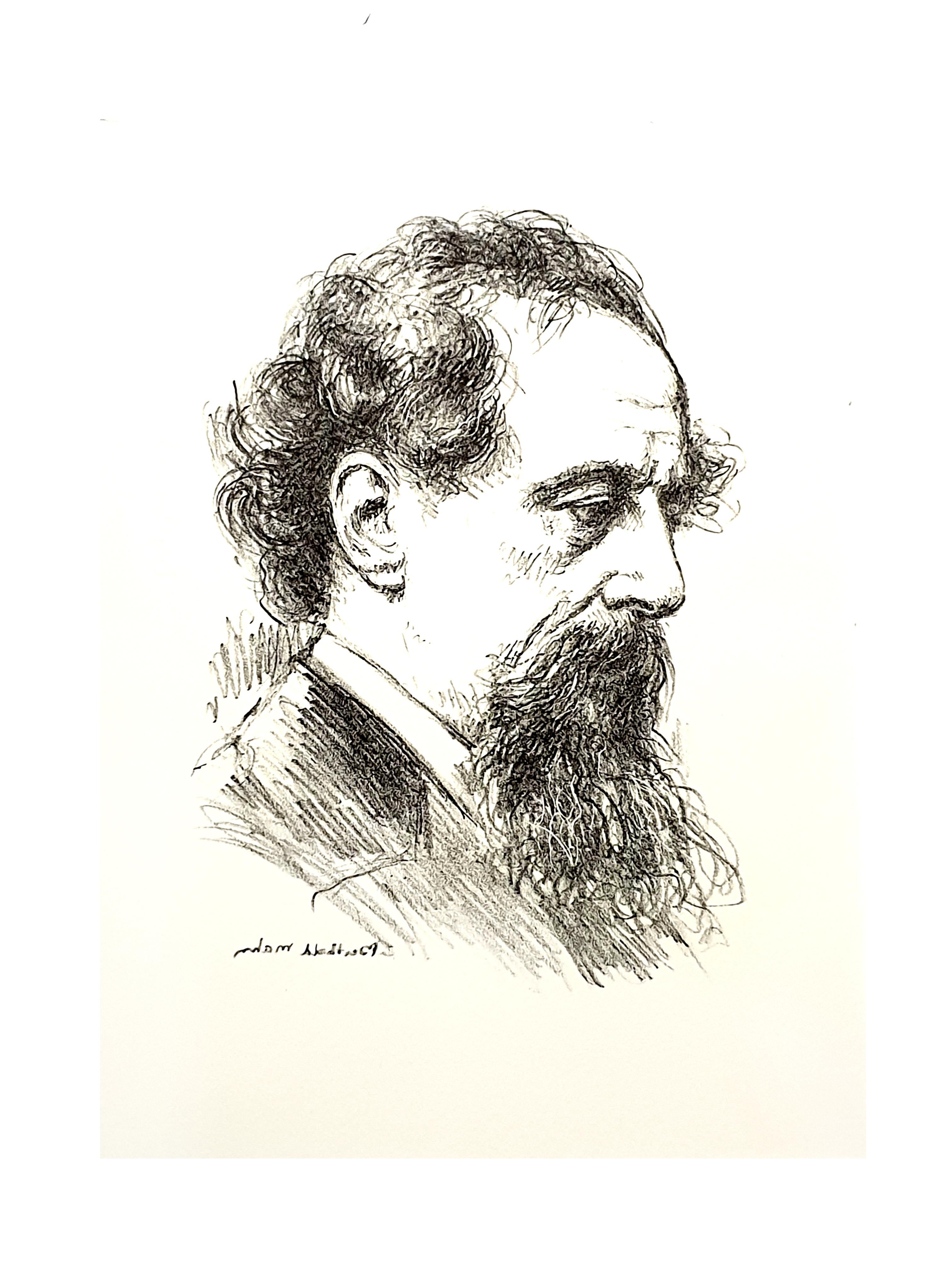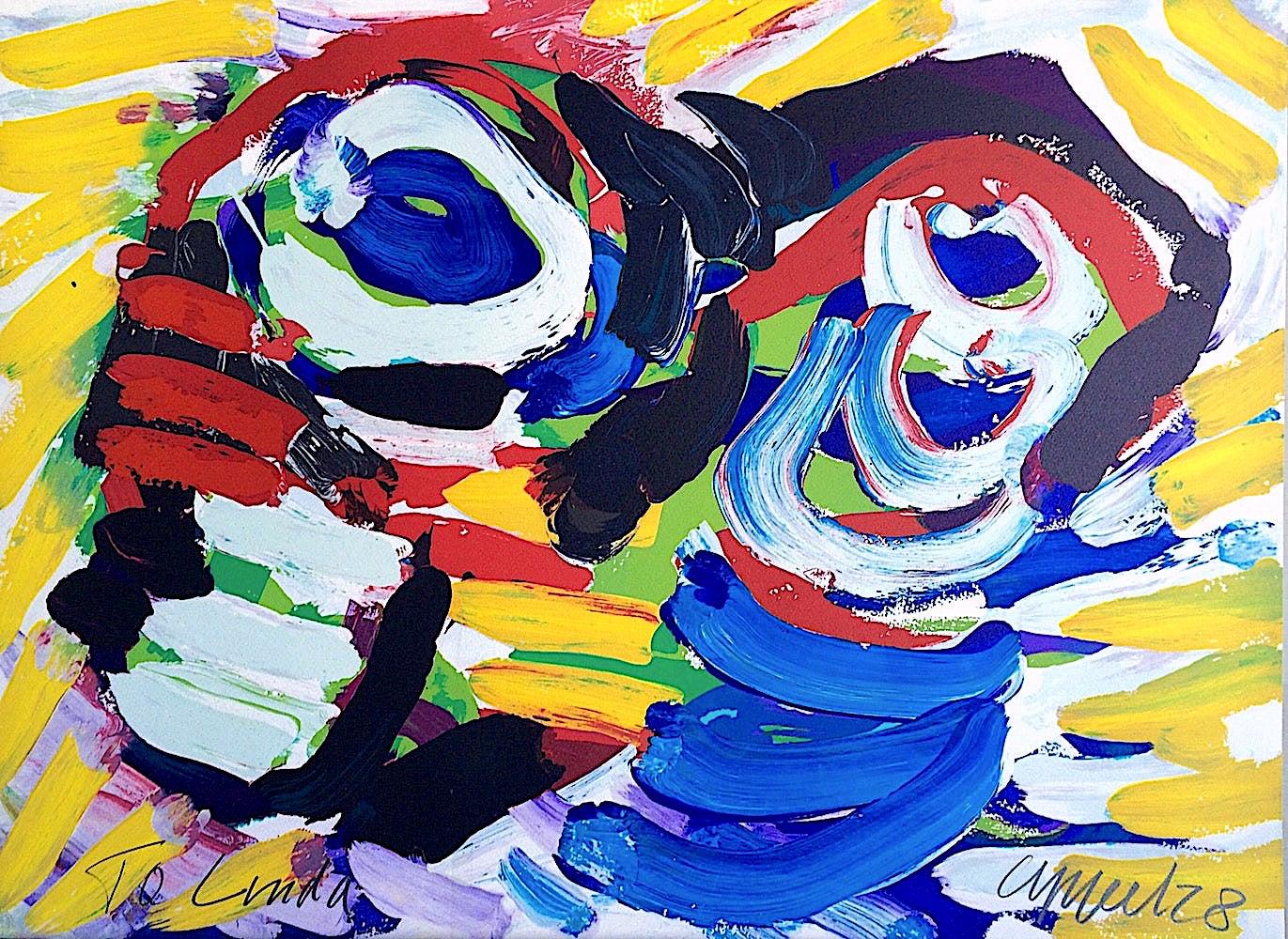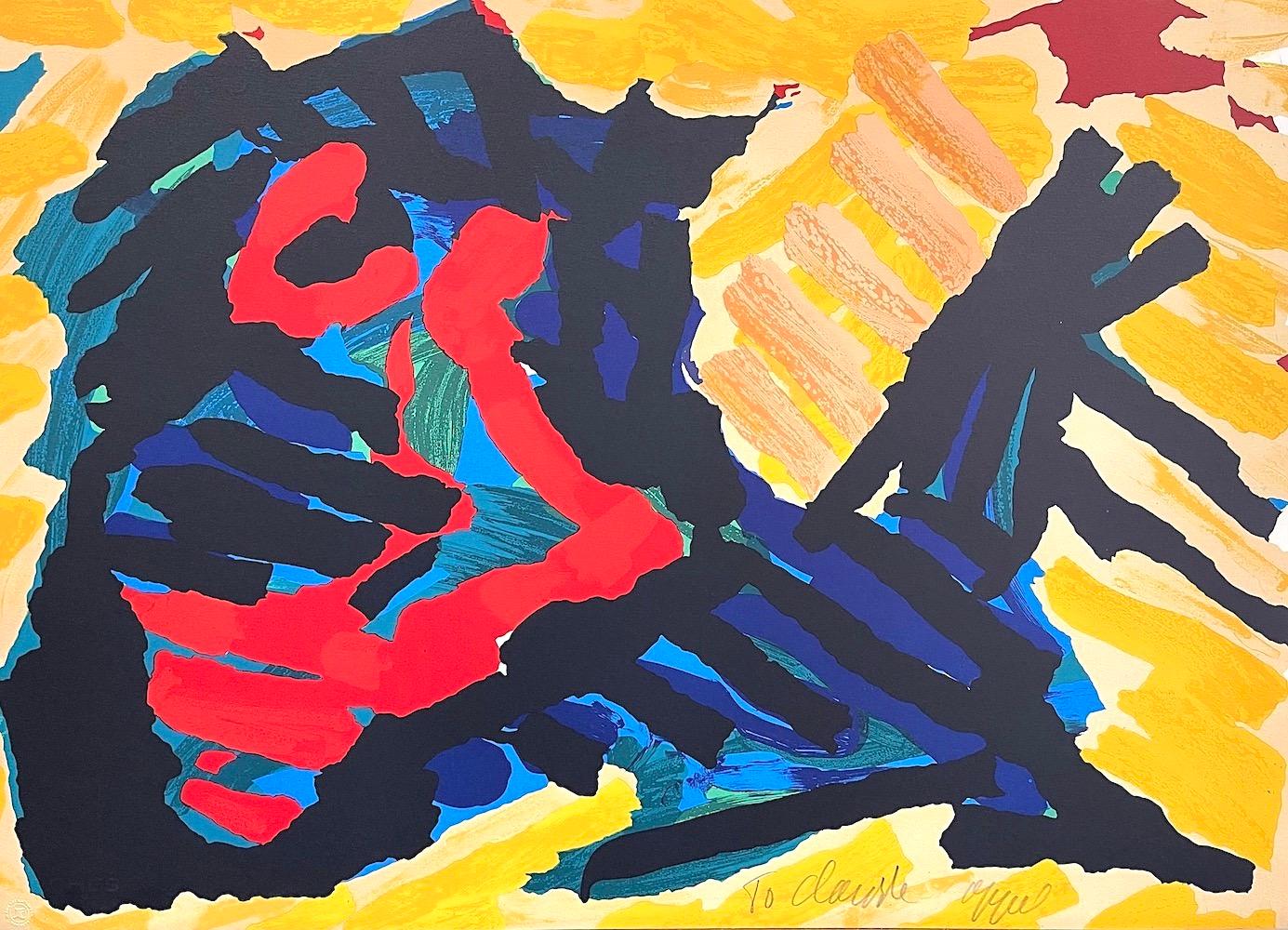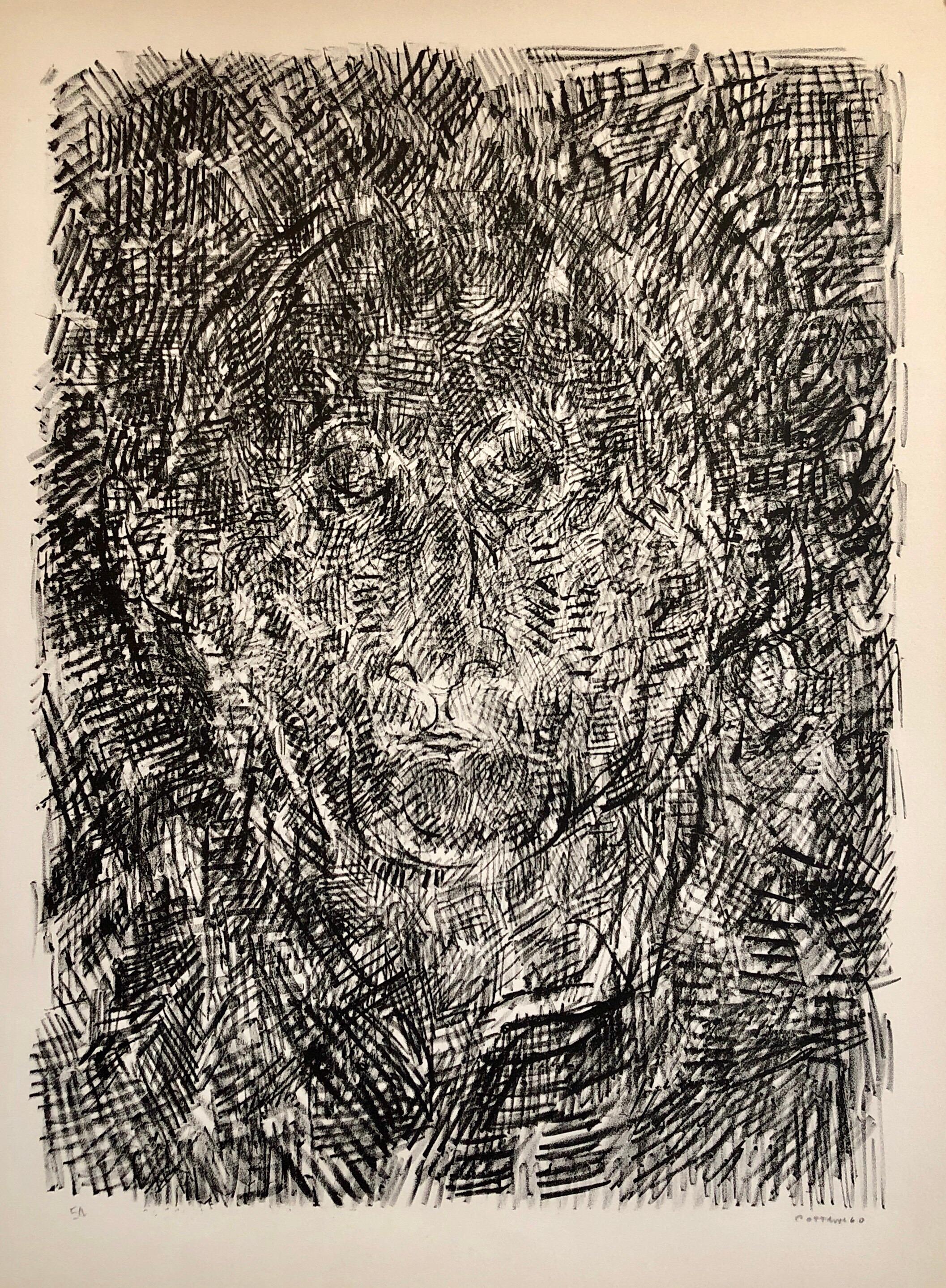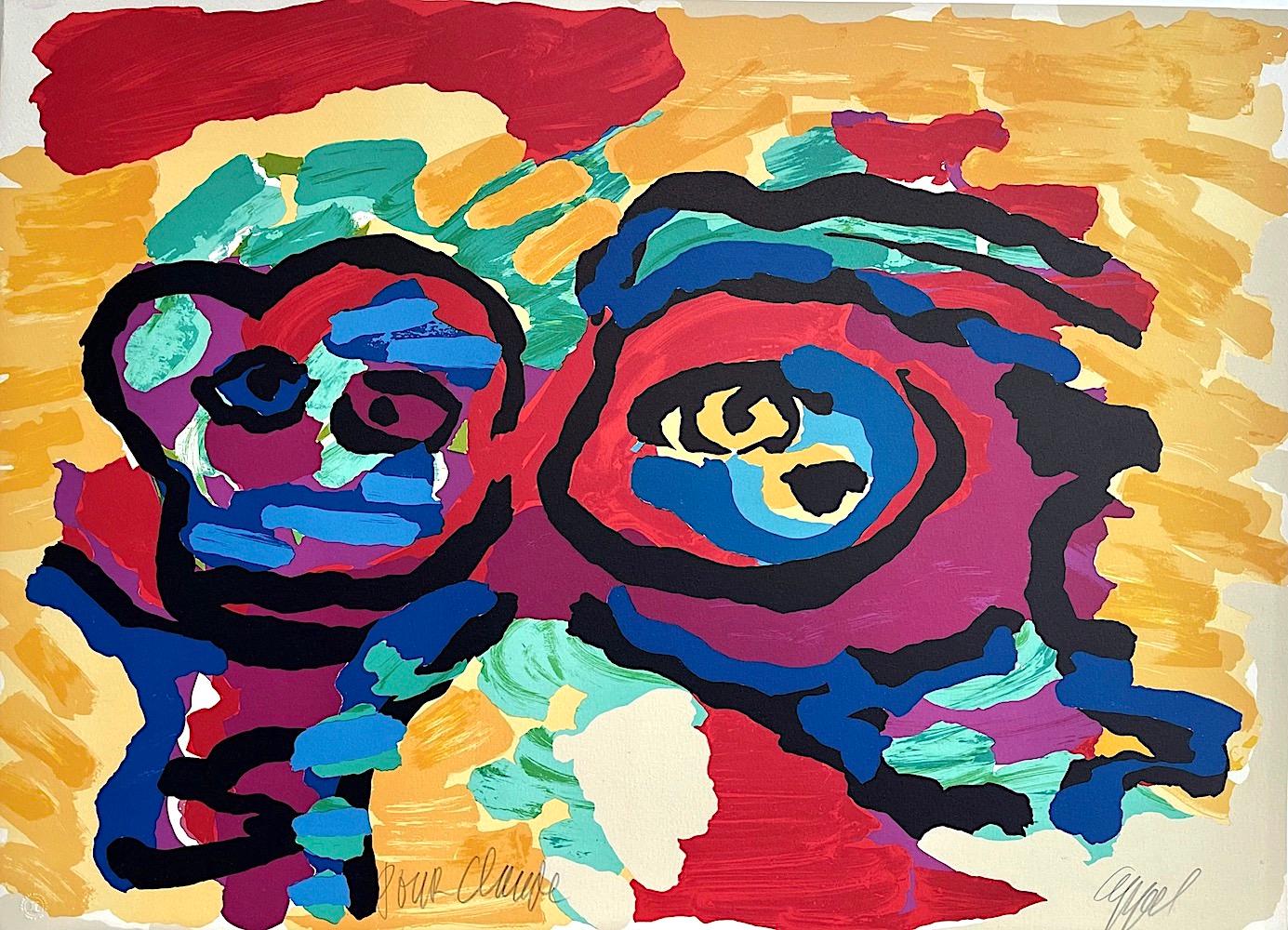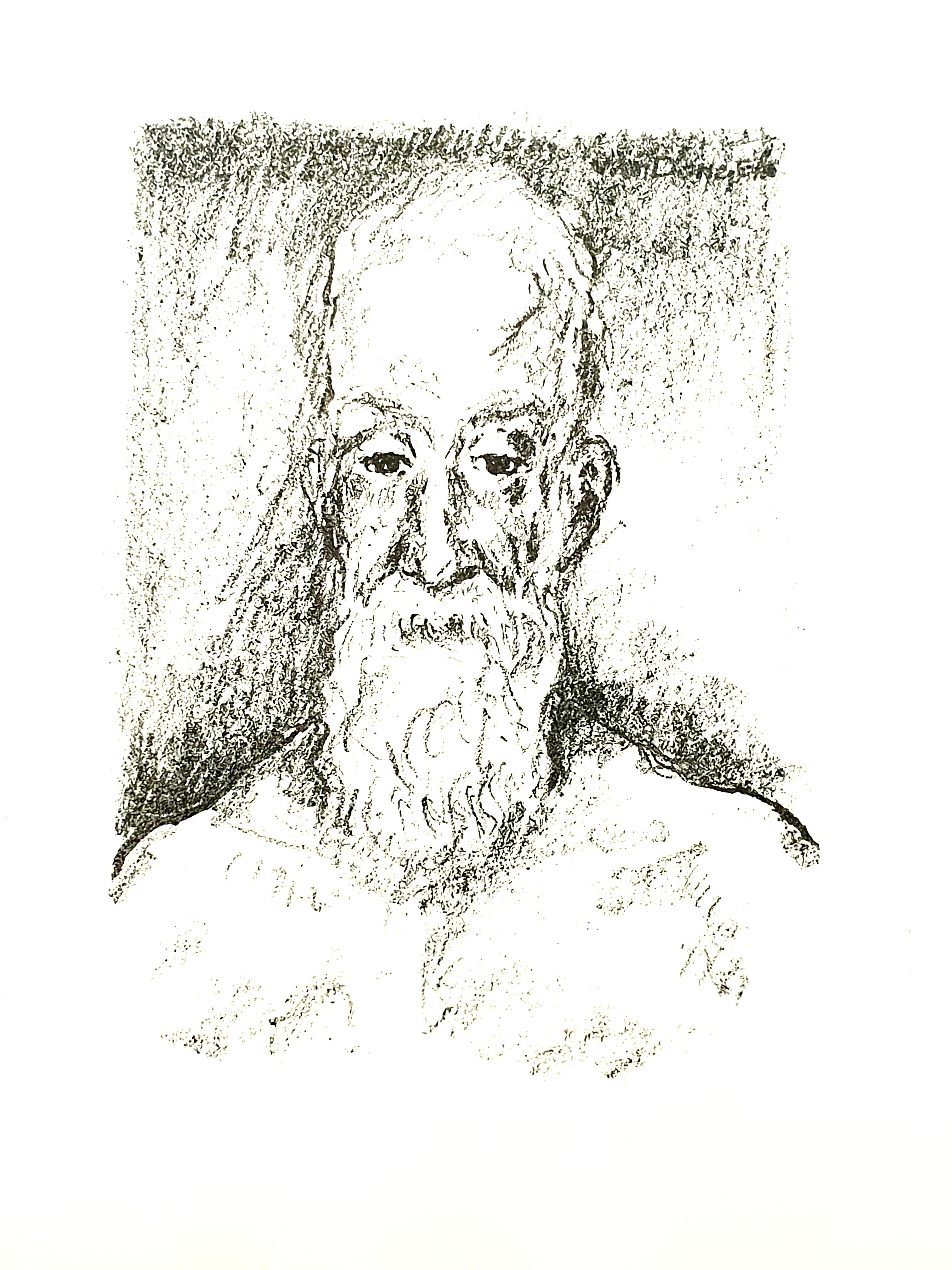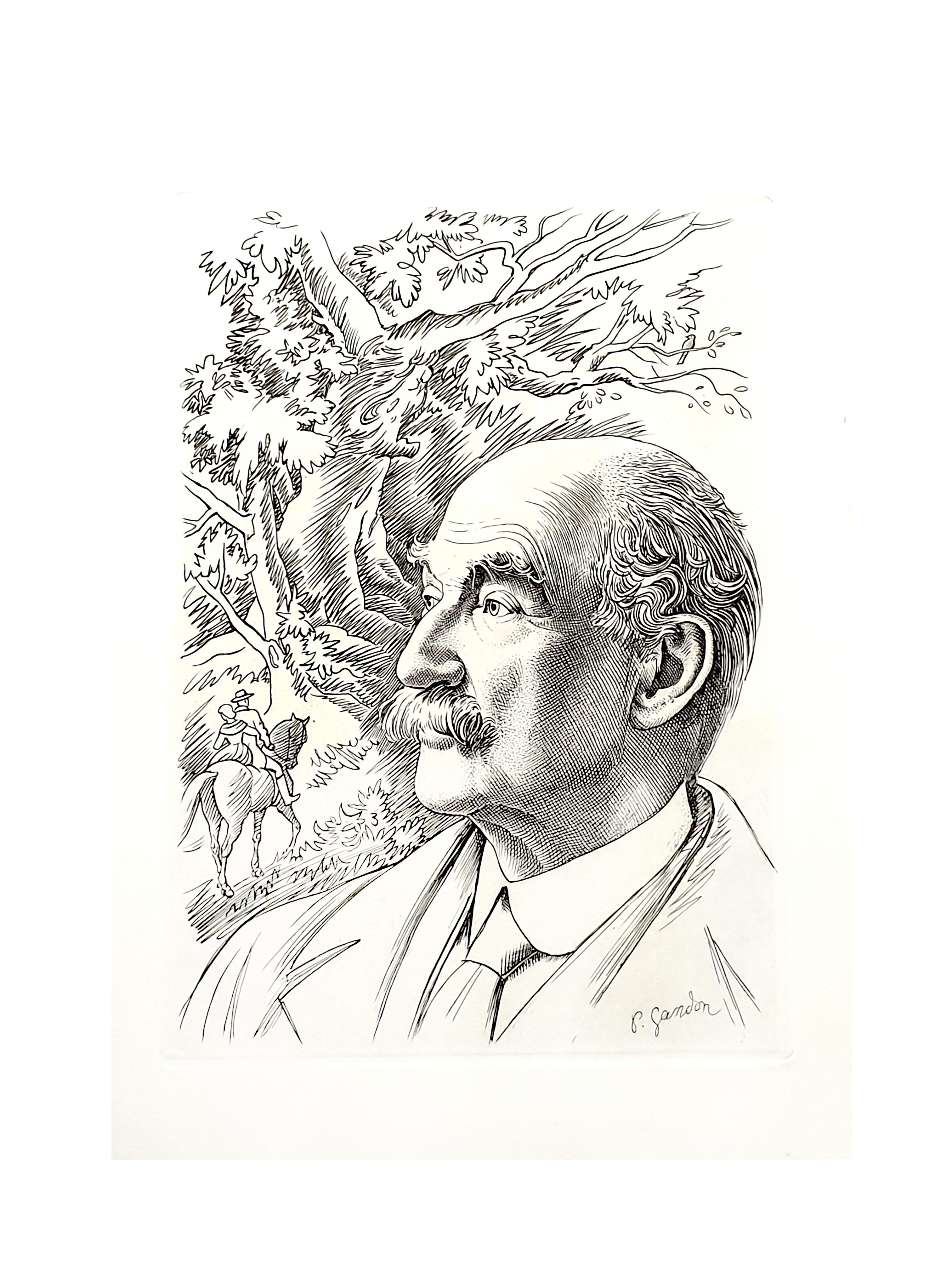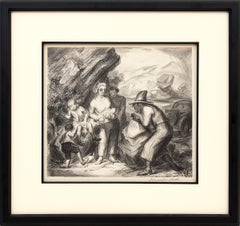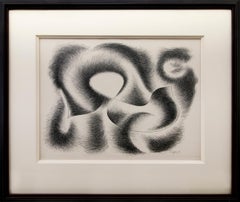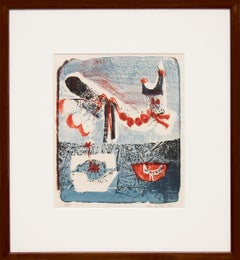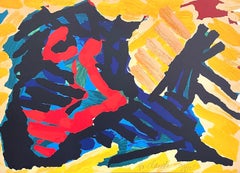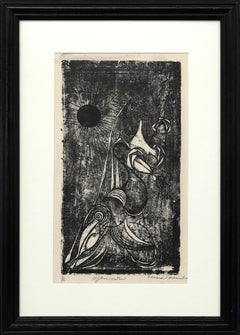
Clytemnestra (2/10), Black and White Abstract Print of Female Figure and the Sun
View Similar Items
Video Loading
Want more images or videos?
Request additional images or videos from the seller
1 of 17
Edward MarecakClytemnestra (2/10), Black and White Abstract Print of Female Figure and the Sun1948
1948
About the Item
- Creator:Edward Marecak (1919 - 1993)
- Creation Year:1948
- Dimensions:Height: 23 in (58.42 cm)Width: 16.25 in (41.28 cm)Depth: 0.75 in (1.91 cm)
- Medium:
- Movement & Style:
- Period:
- Framing:Frame IncludedFraming Options Available
- Condition:
- Gallery Location:Denver, CO
- Reference Number:Seller: 260991stDibs: LU27310466702
About the Seller
5.0
Platinum Seller
These expertly vetted sellers are 1stDibs' most experienced sellers and are rated highest by our customers.
Established in 1979
1stDibs seller since 2013
264 sales on 1stDibs
Typical response time: 5 hours
More From This SellerView All
- Tourists, Garden of the Gods, Colorado Springs, Colorado, 1930s Lithograph PrintBy Charles LockeLocated in Denver, COPhoto Opportunity (Tourists, Garden of the Gods, Colorado Springs, Colorado; edition of 30 is a lithograph circa 1935 by Charles Wheeler Locke (1899-19...Category
1930s American Modern Figurative Prints
MaterialsPaper, Lithograph
- Convolution, 1940s Modern Black White Abstract Lithograph of Kinetic MovementBy Herbert BayerLocated in Denver, CO"Convolution" is a lithograph on paper by Herbert Bayer (1900-1985) from 1948 of an abstract kinetic movement shape. Presented framed in all archival materials, outer dimensions measure 23 x 26 ¾ x 1 ¼ inches. Image sight size is 17 x 22 inches. Print is clean and in very good condition - please contact us for a detailed condition report. Expedited and international shipping is available - please contact us for a quote. About the Artist: Herbert Bayer Born 1900, Haag am Hausruck, Ausstria Died 1985, Montecito, California Herbert Bayer enjoyed a versatile sixty-year career spanning Europe and America that included abstract and surrealist painting, sculpture, environmental art, industrial design, architecture, murals, graphic design, lithography, photography and tapestry. He was one of the few “total artists” of the twentieth century, producing works that “expressed the needs of an industrial age as well as mirroring the advanced tendencies of the avant-garde.” One of four children of a tax revenue officer growing up in a village in the Austrian Salzkammergut Lake region, Bayer developed a love of nature and a life-long attachment to the mountains. A devotee of the Vienna Secession and the Vienna Workshops (Wiener Werkstätte) whose style influenced Bauhaus craftsmen in the 1920s, his dream of studying at the Academy of Art in Vienna was dashed at age seventeen by his father’s premature death. In 1919 Bayer began an apprenticeship with architect and designer, Georg Schmidthamer, where he produced his first typographic works. Later that same year he moved to Darmstadt, Germany, to work at the Mathildenhöhe Artists’ Colony with architect Emanuel Josef Margold of the Viennese School. As his working apprentice, Bayer first learned about the design of packages – something entirely new at the time – as well as the design of interiors and graphics of a decorative expressionist style, all of which later figured in his professional career. While at Darmstadt, he came across Wassily Kandinsky’s book, Concerning the Spiritual in Art, and learned of the new art school, the Weimar Bauhaus, in which he enrolled in 1921. He initially attended Johannes Itten’s preliminary course, followed by Wassily Kandinsky’s workshop on mural painting. Bayer later recalled, “The early years at the Bauhaus in Weimar became the formative experience of my subsequent work.” Following graduation in 1925, he was appointed head of the newly-created workshop for print and advertising at the Dessau Bauhaus that also produced the school’s own print works. During this time he designed the “Universal” typeface emphasizing legibility by removing the ornaments from letterforms (serifs). Three years later he left the Bauhaus to focus more on his own artwork, moving to Berlin where he worked as a graphic designer in advertising and as an artistic director of the Dorland Studio advertising agency. (Forty years later he designed a vast traveling exhibition, catalog and poster -- 50 Jahre Bauhaus -- shown in Germany, South America, Japan, Canada and the United States.) In pre-World War II Berlin he also pursued the design of exhibitions, painting, photography and photomontage, and was art director of Vogue magazine in Paris. On account of his previous association with the Bauhaus, the German Nazis removed his paintings from German museums and included him among the artists in a large exhibition entitled Degenerate Art (Entartete Kunst) that toured German and Austrian museums in 1937. His inclusion in that exhibition and the worsening political conditions in Nazi Germany prompted him to travel to New York that year with Marcel Breuer, meeting with former Bauhaus colleagues, Walter Gropius and László Moholy-Nagy to explore the possibilities of employment after immigration to the United States. In 1938 Bayer permanently relocated to the United States, settling in New York where he had a long and distinguished career in practically every aspect of the graphic arts, working for drug companies, magazines, department stores, and industrial corporations. In 1938 he arranged the exhibition, “Bauhaus 1919-1928” at the Museum of Modern Art, followed later by “Road to Victory” (1942, directed by Edward Steichen), “Airways to Peace” (1943) and “Art in Progress” (1944). Bayer’s designs for “Modern Art in Advertising” (1945), an exhibition of the Container Corporation of America (CAA) at the Art Institute of Chicago, earned him the support and friendship of Walter Paepcke, the corporation’s president and chairman of the board. Paepcke, whose embrace of modern currents and design changed the look of American advertising and industry, hired him to move to Aspen, Colorado, in 1946 as a design consultant transforming the moribund mountain town into a ski resort and a cultural center. Over the next twenty-eight years he became an influential catalyst in the community as a painter, graphic designer, architect and landscape designer, also serving as a design consultant for the Aspen Cultural Center. In the summer of 1949 Bayer promoted through poster design and other design work Paepcke’s Goethe Bicentennial Convocation attended by 2,000 visitors to Aspen and highlighted by the participation of Albert Schweitzer, Arthur Rubenstein, Jose Ortega y Gasset and Thornton Wilder. The celebration, held in a tent designed by Finnish architect Eero Saarinen, led to the establishment that same year of the world-famous Aspen Music Festival and School regarded as one of the top classical music venues in the United States, and the Aspen Institute for Humanistic Studies in (now the Aspen Institute), promoting in Paepcke’s words “the cross fertilization of men’s minds.” In 1946 Bayer completed his first architecture design project in Aspen, the Sundeck Ski Restaurant, at an elevation of 11,300 feet on Ajax Mountain. Three years later he built his first studio on Red Mountain, followed by a home which he sold in 1953 to Robert O. Anderson, founder of the Atlantic Richfield Company who became very active in the Aspen Institute. Bayer later designed Anderson’s terrace home in Aspen (1962) and a private chapel for the Anderson family in Valley Hondo, New Mexico (1963). Transplanting German Bauhaus design to the Colorado Rockies, Bayer created along with associate architect, Fredric Benedict, a series of buildings for the modern Aspen Institute complex: Koch Seminar Building (1952), Aspen Meadows guest chalets and Center Building (both 1954), Health Center and Aspen Meadows Restaurant (Copper Kettle, both 1955). For the grounds of the Aspen Institute in 1955 Bayer executed the Marble Garden and conceived the Grass Mound, the first recorded “earthwork” environment In 1973-74 he completed Anderson Park for the Institute, a continuation of his fascination with environmental earth art. In 1961 he designed the Walter Paepcke Auditorium and Memorial Building, completing three years later his most ambitious and original design project – the Musical Festival Tent for the Music Associates of Aspen. (In 2000 the tent was replaced with a design by Harry Teague.) One of Bayer’s ambitious plans from the 1950s, unrealized due to Paepcke’s death in 1960, was an architectural village on the outskirts of the Aspen Institute, featuring seventeen of the world’s most notable architects – Walter Gropius, Marcel Breuer, I.M. Pei, Minoru Yamasaki, Edward Durrell Stone and Phillip Johnson – who accepted his offer to design and build houses. Concurrent with Bayer’s design and consultant work while based in Aspen for almost thirty years, he continued painting, printmaking, and mural work. Shortly after relocating to Colorado, he further developed his “Mountains and Convolutions” series begun in Vermont in 1944, exploring nature’s fury and repose. Seeing mountains as “simplified forms reduced to sculptural surface in motion,” he executed in 1948 a series of seven two-color lithographs (edition of 90) for the Colorado Springs Fine Arts Center. Colorado’s multi-planal typography similarly inspired Verdure, a large mural commissioned by Walter Gropius for the Harkness Commons Building at Harvard University (1950), and a large exterior sgraffito mural for the Koch Seminar Building at the Aspen Institute (1953). Having exhausted by that time the subject matter of “Mountains and Convulsions,” Bayer returned to geometric abstractions which he pursued over the next three decades. In 1954 he started the “Linear Structure” series containing a richly-colored balance format with bands of sticks of continuously modulated colors. That same year he did a small group of paintings, “Forces of Time,” expressionist abstractions exploring the temporal dimension of nature’s seasonal molting. He also debuted a “Moon and Structure” series in which constructed, architectural form served as the underpinning for the elaboration of color variations and transformations. Geometric abstraction likewise appeared his free-standing metal sculpture, Kaleidoscreen (1957), a large experimental project for ALCOA (Aluminum Corporation of America) installed as an outdoor space divider on the Aspen Meadows in the Aspen Institute complex. Composed of seven prefabricated, multi-colored and textured panels, they could be turned ninety degrees to intersect and form a continuous plane in which the panels recomposed like pieces of a jigsaw puzzle. He similarly used prefabricated elements for Articulated Wall, a very tall free-standing sculpture commissioned for the Olympic Games in Mexico...Category
1940s Abstract Abstract Prints
MaterialsPaper, Lithograph
- 1960s Abstract American Modernist Pencil Signed Colored Lithograph PrintLocated in Denver, CO1966 American Modernist abstract color lithograph by Lewis Lee Tilley (1921-2005). The print is singed and editioned/numbered 4 of 5 prints by the artist. Presented in a custom frame, outer dimensions measure 29 x 23 inches. Image size is 12 ½ x 10 ½ inches. Piece is clean and in very good condition - please contact us for a detailed condition report. Provenance: Fremont Center for the Arts, Canon City...Category
1960s Abstract Abstract Prints
MaterialsPaper, Lithograph
- 1940s Vertical American Modern Mining Town Landscape Lithograph, Mountain SceneBy Otis DozierLocated in Denver, COLithograph titled "Mining Town" by Otis Dozier (1904-1987) from 1940. Modernist scene of a mountain mining town with several buildings at the base of the mountain. Presented in a custom black frame, outer dimensions measure 25 ½ x 18 ⅜ x ¼ inches. Image sight size is 16 ¼ x 9 ½ inches. Print is clean and in very good condition - please contact us for a detailed condition report. Provenance: Private Collection, Denver, Colorado Expedited and international shipping is available - please contact us for a quote. About the Artist: Born in Forney, Texas, Otis Marion Dozier was raised on a farm in Mesquite, Texas. Dozier was a muralist, potter, lithographer, sculptor, and painter. Dozier was a member of a group of Texas regionalist artists known as the "Dallas Nine." His surroundings in Texas became the focus of much of his art. Dozier’s first artistic training took place in the early 1920’s when his family moved to Dallas. He studied under Vivian Aunspaugh, Cora Edge, and Frank Reaugh...Category
1940s Abstract Abstract Prints
MaterialsPaper, Lithograph
- Group of Five 1980s Abstract Lithographs Individually Titled, Red & BlackBy Dale ChismanLocated in Denver, COGroup of five abstract lithographs signed and individually titled by artist Dale Chisman from 1987. Titles are: At Midnight, I Breathed A Gentle Fragrance, If You Love for Beauty's S...Category
1980s Abstract Abstract Prints
MaterialsLithograph, Archival Paper
- Card Players (16/100), 1959 Framed Figurative Lithograph Print, Interior SceneBy Kenneth Miller AdamsLocated in Denver, COLithograph by Kenneth Miller Adams (1897-1966) titled "Card Players 16/100" circa 1959. Interior scene with several male figures sitting around a table enjoying a card game. Presented in a black frame with archival materials, outer dimensions measure 25 ⅝ x 31 ¼ x 1 ⅛ inches. Image sight size is 18 ½ x 24 ¼ inches. Print is clean and in good condition - please contact us for a detailed condition report. Provenance: Private Collection, Denver, Colorado Expedited and international shipping is available - please contact us for a quote. About the Artist: Kenneth Adams was born in Kansas, and first started his art career in Topeka during 1913. He studied with artist, G.M. Stone, who became the basis for his formal education that began three years later at the Art Institute of Chicago. Adams served in WWI, and when he was discharged, he moved to New York City to study at the Art Students League. Soon after completing courses there, Adams moved abroad to study Italian and French art. In 1924, Adams was back in Kansas, where his friend Andrew Dasburg encouraged him to move to New Mexico. Adams settled in Taos, and remained there for the next twelve years. He was the youngest and last member of the Taos Society...Category
1950s American Modern Portrait Prints
MaterialsLithograph
You May Also Like
- Berthold Mahn - Portrait - Original LithographLocated in Collonge Bellerive, Geneve, CHBerthold Mahn - Portrait - Original Lithograph 1956 Signed in the plate Dimensions: 22 x 16 cm Publisher: Sauret. Frontispice of "Great Expectations" Un...Category
1950s Abstract Expressionist Abstract Prints
MaterialsLithograph
- HAPPY COUPLE I Signed Lithograph, Abstract Portrait, Yellow, Blue, Black, RedBy Karel AppelLocated in Union City, NJHAPPY COUPLE I is a limited edition lithograph by the Dutch artist Karel Appel printed in 1978 in New York City using traditional hand lithography techniques on archival printmaking...Category
1970s Abstract Abstract Prints
MaterialsLithograph
$1,480 Sale Price20% Off - RUNNING HORSE Signed Lithograph, Abstract Animal, CoBrA ArtistBy Karel AppelLocated in Union City, NJRUNNING HORSE is an original hand drawn, limited edition lithograph by the Dutch artist Karel Appel printed using hand lithography techniques on Arches paper, 100% acid free. RUNNING...Category
1970s Abstract Abstract Prints
MaterialsLithograph
- French Modernist Abstract Portrait Lithograph (After Jasper Johns)By André CottavozLocated in Surfside, FLBorn in 1922 in Saint-Marcellin, in Isère, André Cottavoz studied at the École des Beaux-Arts in Lyon in 1939. In 1942, Cottavoz at 20 years, he is in class 22 and must go to the Com...Category
1960s Abstract Abstract Prints
MaterialsLithograph
- Mystery of Womanhood 1947 original signed Emilio Pucci Kaleidoscopic lithographBy Emilio PucciLocated in Paonia, COMystery of Womanhood is an original 1947 pencil signed limited edition ( 31 / 100 ) lithograph by Emilio Pucci. It is from a set of six lithographs...Category
1940s Abstract Expressionist Abstract Prints
MaterialsLithograph
- HAPPY COUPLE Signed Lithograph, Colorful Abstract Portrait, CoBrA ArtistBy Karel AppelLocated in Union City, NJHAPPY COUPLE is an original limited edition lithograph by the Dutch artist Karel Appel printed using hand lithography techniques on Somerset paper, 100% acid free. HAPPY COUPLE is a ...Category
1970s Abstract Abstract Prints
MaterialsLithograph
Recently Viewed
View AllMore Ways To Browse
Andy Warhol Soup Prints
Modern Colorful Wood Sculpture
Pastel Portrait Sketch
Native Chief
Andy Warhol Campbells Soup Cans
Andy Warhol Marilyn Signed
Picasso Blue Woman
Warhol Campbell Soup Print
Campbell Soup Vintage
Vintage Campbell Soup
Native Indian Portraits
Portrait Femme Vintage
American Indian Chief
Woodblock Portrait
Portrait Prints Of American Indians
Native Indian In Portrait
Native American Chief
Warhol Soup Can Print
